Bird R.B., Stewart W.E., Lightfoot E.N. Transport Phenomena
Подождите немного. Документ загружается.

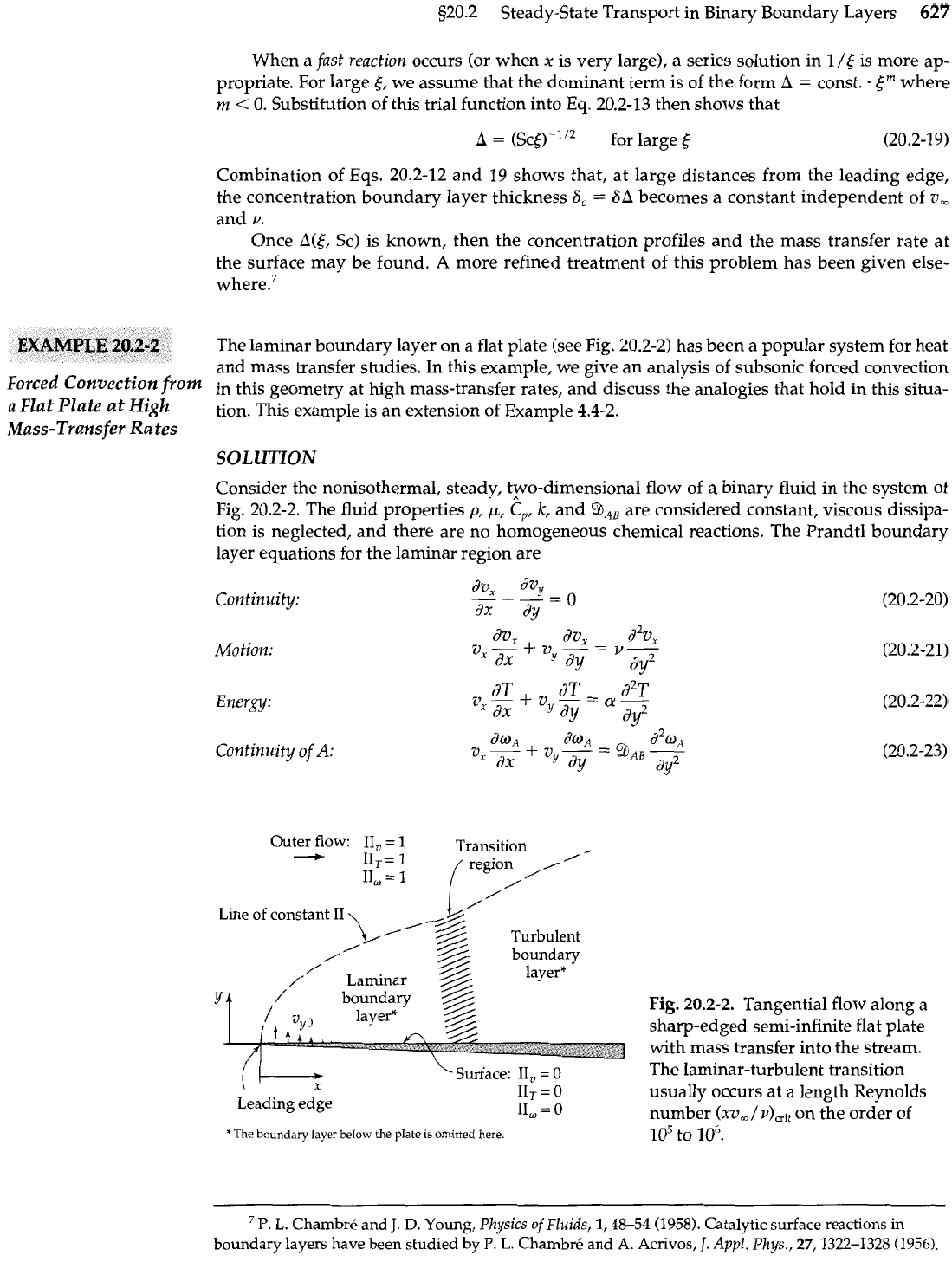
520.2 Steady-State Transport in Binary Boundary Layers
627
When a fast reaction occurs (or when
x
is very large), a series solution in I/( is more ap-
propriate. For large t, we assume that the dominant term is of the form
A
=
const.
e
5"
where
rn
<
0. Substitution of this trial function into Eq. 20.2-13 then shows that
A
=
(sc@-~/~
for large
5
(20.2-19)
Combination of Eqs. 20.2-12 and 19 shows that, at large distances from the leading edge,
the concentration boundary layer thickness
6,
=
6A
becomes a constant independent of
v,
and
v.
Once
A@,
Sc) is known, then the concentration profiles and the mass transfer rate at
the surface may be found.
A
more refined treatment of this problem has been given else-
where.7
The laminar boundary layer on
a
flat plate (see Fig. 20.2-2) has been a popular system for heat
and mass transfer studies. In this example, we give an analysis of subsonic forced convection
Forced
Convection
from
in this geometry at high mass-transfer rates, and discuss the analogies that hold in this situa-
a
Flat Plate
at
High
tion. This example is an extension of Example
4.4-2.
Mass-Transfer Rates
SOLUTION
Consider the nonisothermal, steady, tyo-dimensional flow of
a
binary fluid in the system of
Fig. 20.2-2. The fluid properties
p,
p,
C,,
k,
and
9,+,
are considered constant, viscous dissipa-
tion is neglected, and there are no homogeneous chemical reactions. The Prandtl boundary
layer equations for the laminar region are
Continuity:
Motion:
Energy:
Continuity of
A.
dv,
dv,
d2vx
v,--+v
-=v-
dx
Y
dy dy2
Outer flow:
11,
=
1
Transition
+
11,
=
1 region
I.
11,
=
1
Line
of
constant
I1
Y
Fig.
20.2-2.
TangentiaI flow along a
sharp-edged semi-infinite flat plate
,
,
with mass transfer into the stream.
The laminar-turbulent transition
IIT
=
0
usually occurs at a length Reynolds
Leading edge
11,
=
0
number
(xv,/v),,,,
on the order of
'The
boundary layer below
the
plate
1s
omitted here
lo5
to lo6.
--
P.
L.
Chambre and
J.
D.
Young,
Physics
of
Fluids,
1,48-54 (1958). Catalytic surface reactions in
boundary layers have been studied
by
P.
L.
Chambr6 and A. Acrivos,
J.
Appl.
Pkys.,
27,1322-1328
(1956).
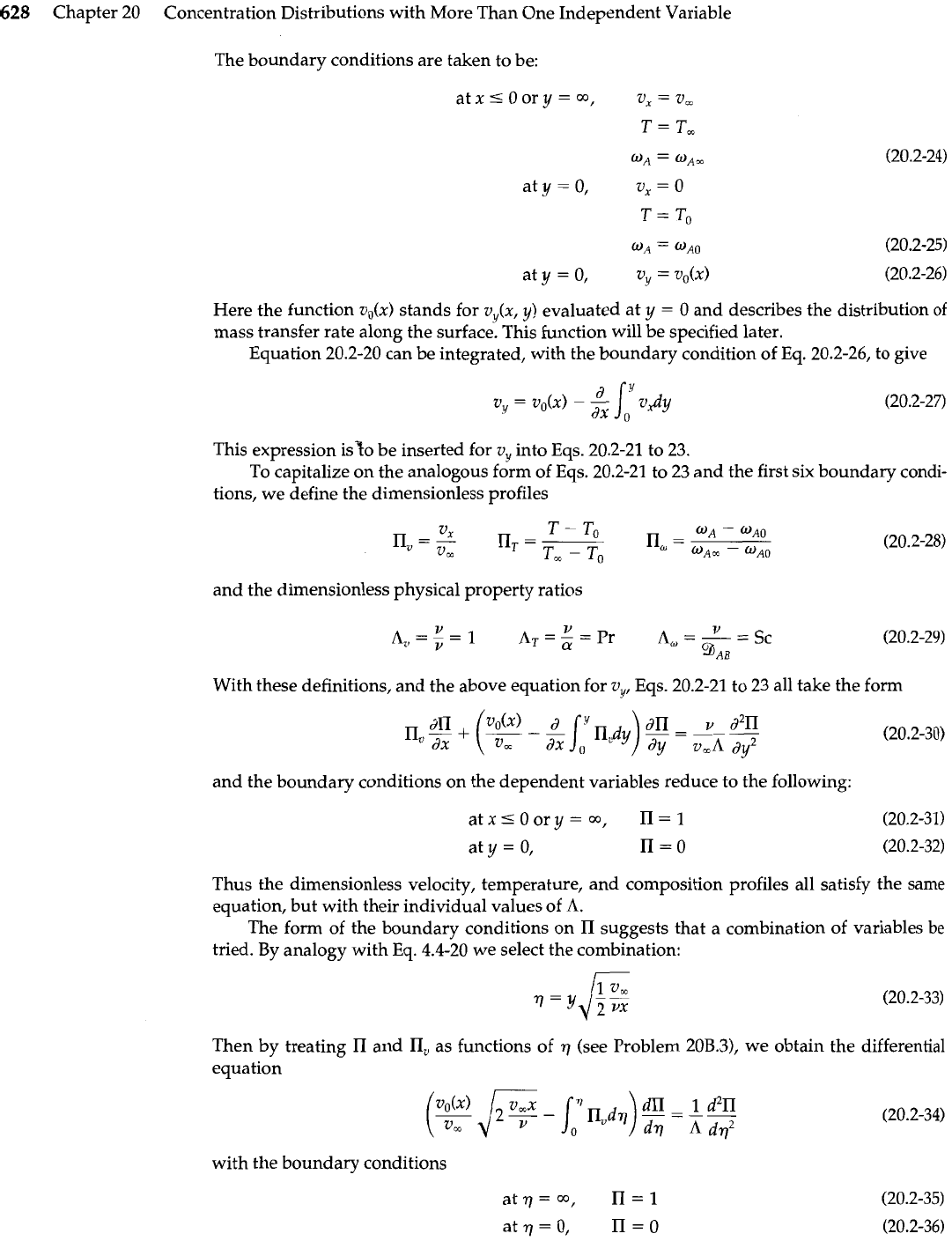
628
Chapter 20
Concentration Distributions with More Than One Independent Variable
The boundary conditions are taken to be:
Here the function vO(x) stands for
V&X,
y)
evaluated at
y
=
0 and describes the distribution
of
mass transfer rate along the surface. This function will be specified later.
Equation 20.2-20 can be integrated, with the boundary condition of Eq. 20.2-26, to give
This expression isto be inserted for v, into Eqs. 20.2-21 to 23.
To capitalize on the analogous form of Eqs. 20.2-21 to 23 and the first six boundary condi-
tions, we define the dimensionless profiles
and the dimensionless physical property ratios
With these definitions, and the above equation for
v,,
Eqs. 20.2-21 to 23 all take the form
and the boundary conditions on the dependent variables reduce to the following:
Thus the dimensionless velocity, temperature, and composition profiles all satisfy the same
equation, but with their individual values of
A.
The form of the boundary conditions on
n
suggests that a combination of variables be
tried. By analogy with
Eq.
4.4-20 we select the combination:
Then by treating
l7
and
as functions of
77
(see Problem 20B.3), we obtain the differential
equation
with the boundary conditions
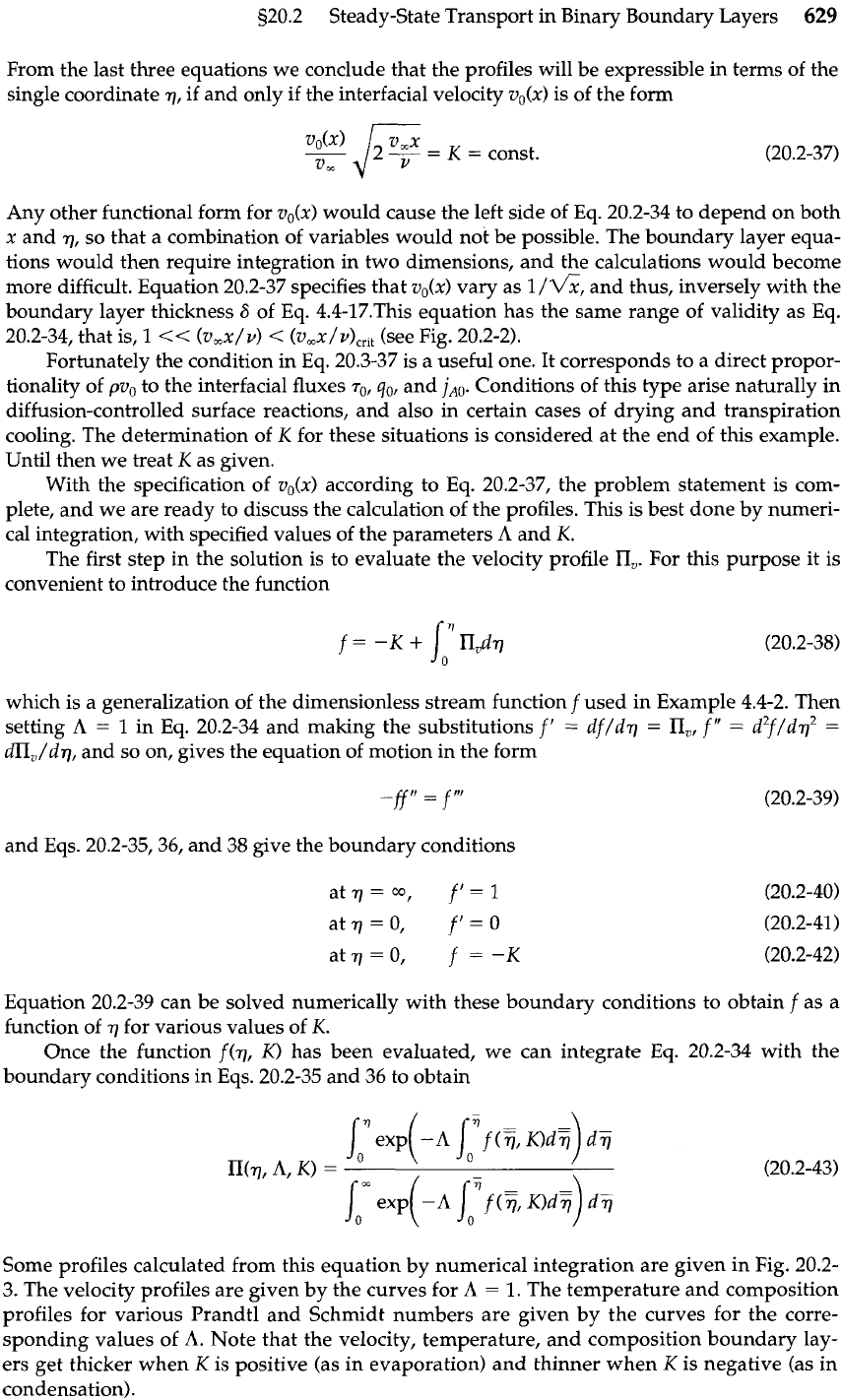
520.2 Steady-State Transport in Binary Boundary Layers
629
From the last three equations we conclude that the profiles will be expressible in terms of the
single coordinate q, if and only if the interfacial velocity vo(x) is of the form
Any other functional form for
v,(x)
would cause the left side of Eq. 20.2-34 to depend on both
x and q,
SO
that a combination of variables would not be possible. The boundary layer equa-
tions would then require integration in two dimensions, and the calculations would become
more difficult. Equation 20.2-37 specifies that vo(x) vary as
1/fi,
and thus, inversely with the
boundary layer thickness
6
of Eq. 4.4-17.This equation has the same range of validity as Eq.
20.2-34, that is,
1
<<
(v,x/v)
<
(v,x/v),,,
(see Fig. 20.2-2).
Fortunately the condition in Eq. 20.3-37 is a useful one. It corresponds to a direct propor-
tionality of pv, to the interfacial fluxes
70,
qO,
and
jAO.
Conditions of this type arise naturally in
diffusion-controlled surface reactions, and also in certain cases of drying and transpiration
cooling. The determination of
K
for these situations is considered at the end of this example.
Until then we treat
K
as given.
With the specification of v,(x) according to Eq. 20.2-37, the problem statement is com-
plete, and we are ready to discuss the calculation of the profiles. This is best done by numeri-
cal integration, with specified values of the parameters
A
and
K.
The first step in the solution is to evaluate the velocity profile ll,. For this purpose it is
convenient to introduce the function
which is a generalization of the dimensionless stream function
f
used in Example 4.4-2. Then
setting
A
=
1
in Eq. 20.2-34 and making the substitutions
f'
=
df/dq
=
II,,
f"
=
d2f/dV2
=
dII,/dv, and so on, gives the equation of motion in the form
and Eqs. 20.2-35,36, and 38 give the boundary conditions
Equation 20.2-39 can be solved numerically with these boundary conditions to obtain
f
as a
function of q for various values of
K.
Once the function f(q,
K)
has been evaluated, we can integrate
Eq.
20.2-34 with the
boundary conditions in Eqs. 20.2-35 and 36 to obtain
Some profiles calculated from this equation by numerical integration are given in Fig. 20.2-
3. The velocity profiles are given by the curves for
A
=
1.
The temperature and composition
profiles for various Prandtl and Schmidt numbers are given by the curves for the corre-
sponding values of
A.
Note that the velocity, temperature, and composition boundary lay-
ers get thicker when
K
is positive (as in evaporation) and thinner when
K
is negative (as in
condensation).
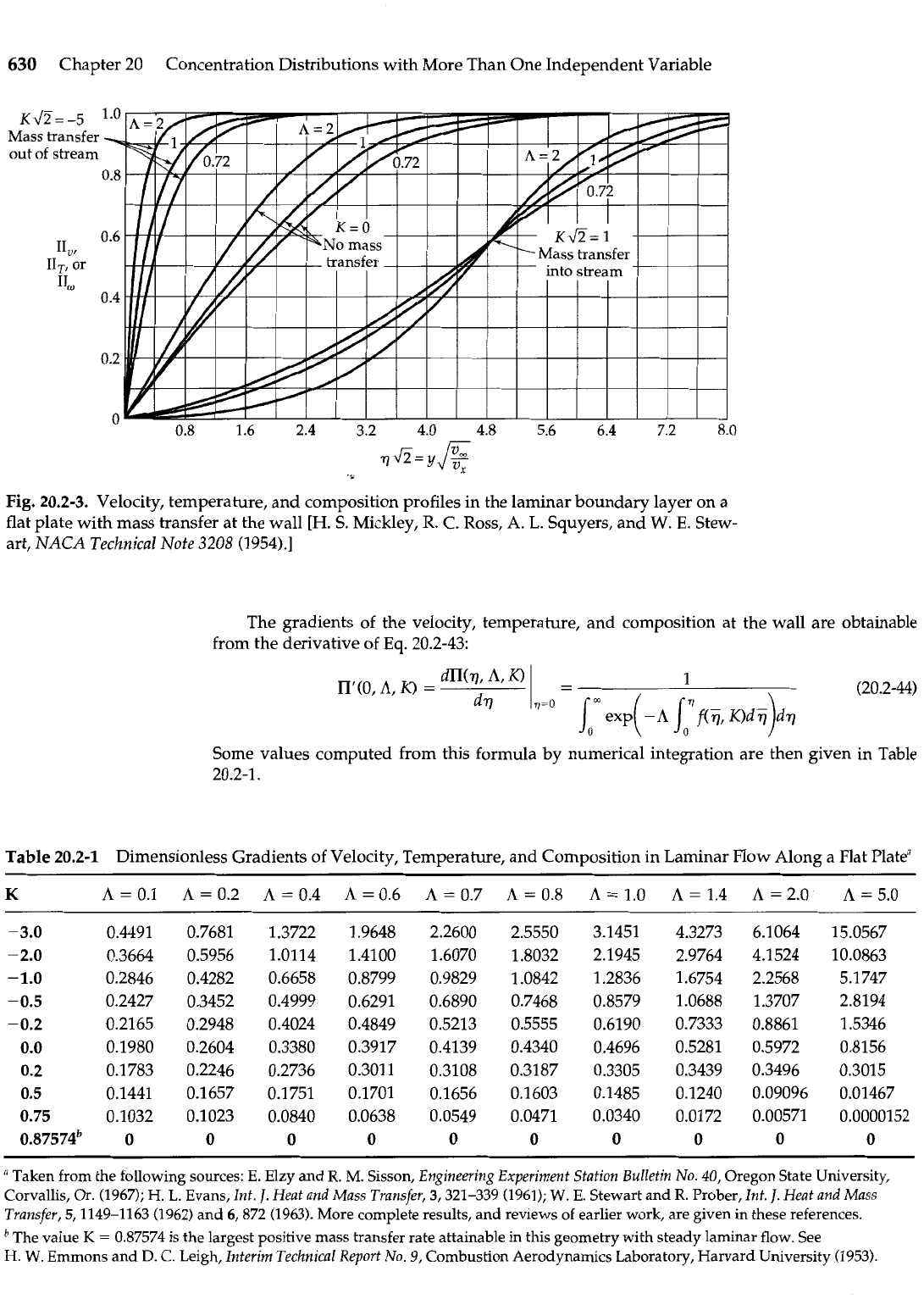
630
Chapter 20 Concentration Distributions with More Than One Independent Variable
Fig.
20.2-3.
Velocity, temperature, and composition profiles in the laminar boundary layer on a
flat plate with mass transfer at the wall
[H.
S.
Mickley,
R.
C.
Ross, A.
L.
Squyers, and
W.
E.
Stew-
art,
NACA
Technical
Note
3208
(1954).1
The gradients of the velocity, temperature, and composition at the wall are obtainable
from the derivative of
Eq.
20.2-43:
Some values computed from this formula by numerical integration are then given in Table
20.2-1.
Table
20.2-1
Dimensionless Gradients of Velocity, Temperature, and Composition in Laminar Flow Along a Flat Plate"
"
Taken from the following sources: E. Elzy and
R.
M.
Sisson,
Engineering Experiment Station Bulletin
No.
40,
Oregon State University,
Corvallis, Or. (1967);
H.
L.
Evans,
Int.
J.
Heat and Mass Transfer,
3,321-339 (1961);
W.
E. Stewart and
R.
Prober,
Int.
J.
Heat and Mass
Transfer,
5,1149-1163 (1962) and 6,872 (1963). More complete results, and reviews of earlier work, are given in these references.
The value
K
=
0.87574 is the largest positive mass transfer rate attainable in this geometry with steady laminar flow. See
H.
W.
Emmons and
D.
C. Leigh,
Interim Technical Report
No.
9,
Combustion Aerodynamics Laboratory, Harvard University (1953).
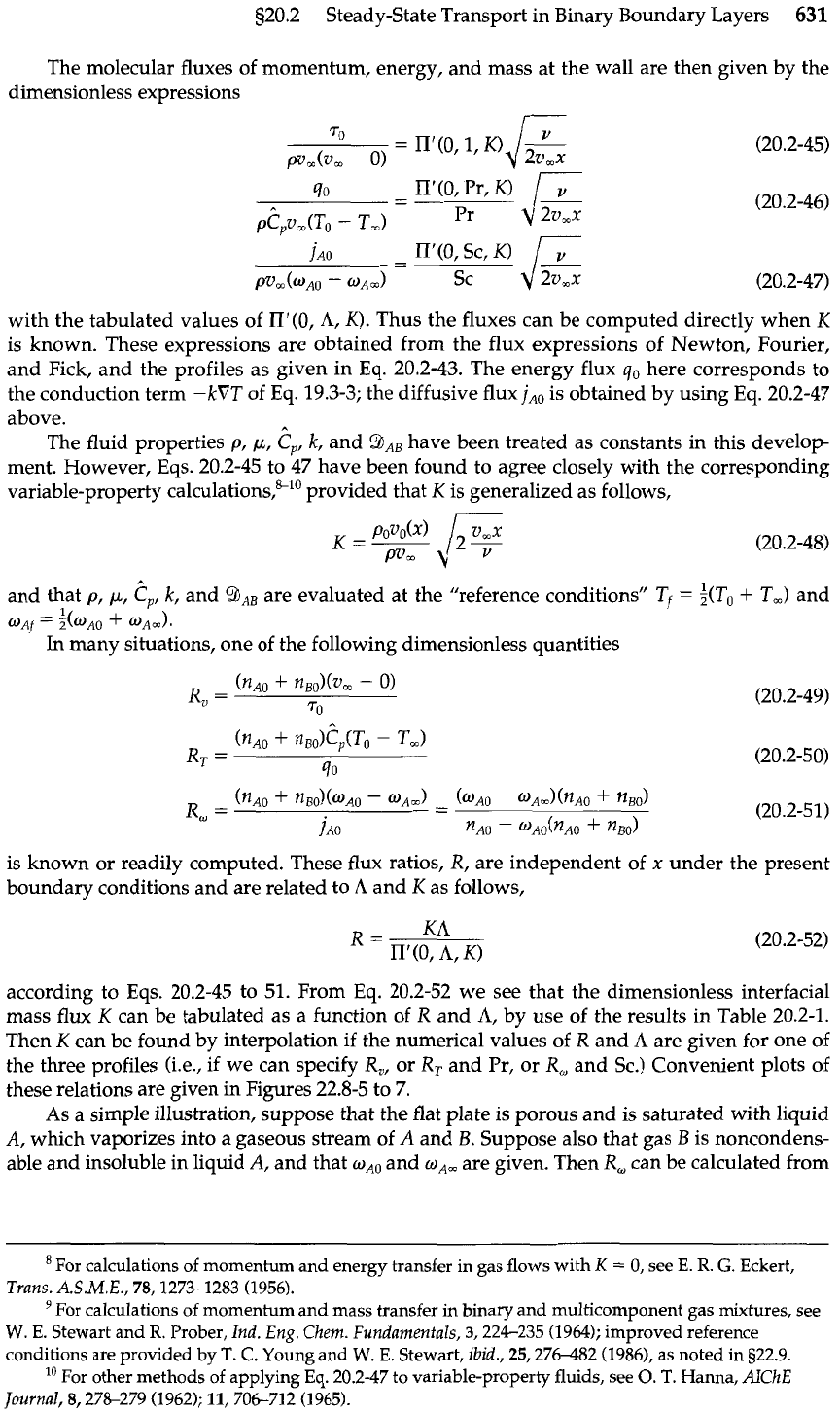
s20.2 Steady-State Transport in Binary Boundary Layers
631
The molecular fluxes of momentum, energy, and mass at the wall are then given by the
dimensionless expressions
with the tabulated values of lI'(0, A,
K).
Thus the fluxes can be computed directly when
K
is known. These expressions are obtained from the flux expressions of Newton, Fourier,
and Fick, and the profiles as given in Eq. 20.2-43. The energy flux
qo
here corresponds to
the conduction term -kVT of Eq. 19.3-3; the diffusive flux j,, is obtained by using Eq. 20.2-47
above.
The fluid properties
p,
p,
ep,
k,
and
PA,
have been treated as constants in this develop
ment. However, Eqs. 20.2-45 to 47 have been found to agree closely with the corresponding
variable-property
calculation^,^'^
provided that
K
is generalized as follows,
and that p,
p,
$,
k, and
are evaluated at the "reference conditions"
Ti
=
:(T,
+
T.)
and
UA~
=
$bAO
+
@Am).
In many situations, one of the following dimensionless quantities
is known or readily computed. These flux ratios, R, are independent of
x
under the present
boundary conditions and are related to A and
K
as follows,
according to Eqs. 20.2-45 to
51.
From Eq. 20.2-52 we see that the dimensionless interfacial
mass flux
K
can be tabulated as a function of
R
and A, by use of the results in Table 20.2-1.
Then
K
can be found by interpolation if the numerical values of R and A are given for one of
the three profiles (i.e., if we can specify
R,,
or R, and Pr, or R, and Sc.) Convenient plots of
these relations are given
in
Figures 22.8-5 to
7.
As a simple illustration, suppose that the flat plate is porous and is saturated with liquid
A, which vaporizes into a gaseous stream of
A
and
B.
Suppose also that gas
B
is noncondens-
able and insoluble in liquid A, and that
wAo
and
o,,
are given. Then R, can be calculated from
-
-
For calculations of momentum and energy transfer in gas flows with
K
=
0,
see
E.
R.
G.
Eckert,
Trans.
A.S.M.E.,
78,1273-1283 (1956).
For calculations of momentum and mass transfer in binary and multicomponent gas mixtures, see
W.
E.
Stewart and
R.
Prober,
Ind.
Eng.
Chem.
Fundamentals,
3,224-235 (1964);
improved reference
conditions are provided
by
T.
C.
Young and
W.
E.
Stewart,
ibid.,
25,276482 (19861,
as noted in
922.9.
lo
For other methods of applying
Eq.
20.2-47
to variable-property fluids, see
0.
T.
Hanna,
AIChE
Joltrnnl,
8,278-279 (1962); 11,706-712 (1965).
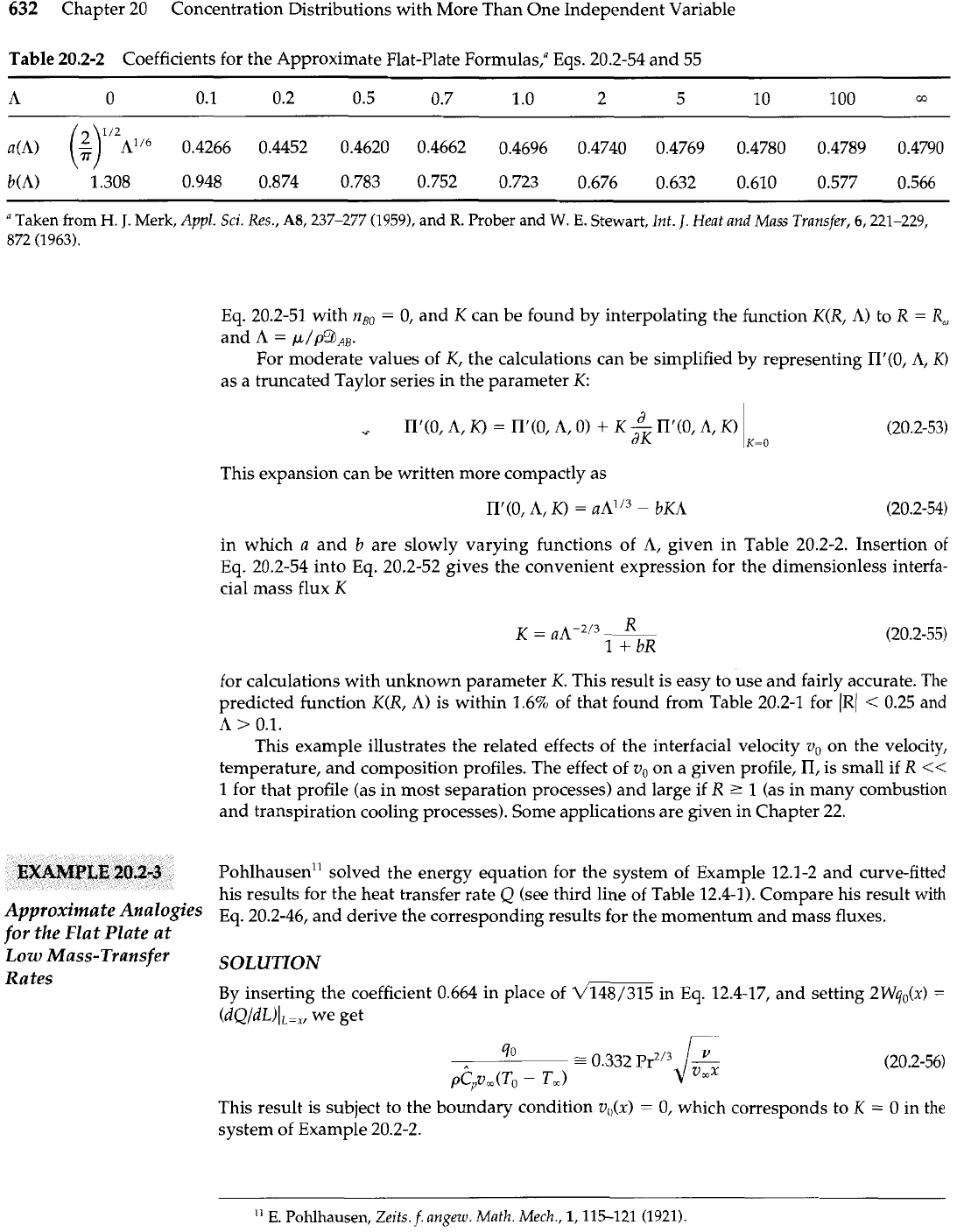
632
Chapter
20
Concentration Distributions with More Than One Independent Variable
Table
20.2-2
Coefficients for the Approximate Flat-Plate Formulas," Eqs.
20.2-54
and
55
"
Taken
from
H.
J.
Merk,
Appl.
Sci.
Res.,
A8,237-277 (1959),
and
R.
Prober and
W.
E.
Stewart,
Int.
1.
Heat and Mass Transfer,
6,221-229,
Eq.
20.2-51
with
n,
=
0,
and
K
can be found by ihterpolating the function
K(R, A)
to
R
=
A,
and
A
=
p/pQAB.
For moderate values of
K,
the calculations can be simplified by representing II'(0,
A,
K)
as a truncated Taylor series in the parameter
K:
This expansion can be written more compactly as
in which
a
and
b
are slowly varying functions of
A,
given in Table
20.2-2.
Insertion of
Eq.
20.2-54
into Eq.
20.2-52
gives the convenient expression for the dimensionless interfa-
cial mass flux
K
for calculations with unknown parameter
K.
This result is easy to use and fairly accurate. The
predicted function
K(R,
A)
is within
1.6%
of that found from Table 20.2-1 for
(R(
<
0.25
and
A
>
0.1.
This example illustrates the related effects of the interfacial velocity v, on the velocity,
temperature, and composition profiles. The effect of
vo
on a given profile,
II,
is small if
R
<<
1
for that profile (as in most separation processes) and large if
R
2
1
(as in many combustion
and transpiration cooling processes). Some applications are given in Chapter
22.
EXAMPLE
20.2-3
Approximate Analogies
for the Flat Plate at
Low Mass-Transfer
Rates
Pohlhausen" solved the energy equation for the system of Example
12.1-2
and curve-fitted
his results for the heat transfer rate Q (see third line of Table
12.4-1).
Compare his result with
Eq.
20.2-46,
and derive the corresponding results for the momentum and mass fluxes.
SOLUTION
By inserting the coefficient
0.664
in place of
v148/315
in Eq.
12.4-17,
and setting 2Wqo(x)
=
(dQldL)I,,,, we get
This result is subject to the boundary condition v,,(x)
=
0,
which corresponds to
K
=
0 in the
system of Example
20.2-2.
"
E.
Pohlhausen,
Zeits.
f.
angew. Math. Mech.,
1,115-121 (1921).

520.3 Steady-State Boundary Layer Theory for Flow Around Objects
633
Equation 20.2-56 is obtainable from Eq. 20.2-46 when
K
=
0 by setting IIf(O, Pr, 0)
=
0.4696~r"~; this agrees with Table 20.2-2 at
A
=
1.
Making comparable substitutions in Eqs.
20.2-45 and 46, we get the convenient analogy
which has been recommended by Chilton and Colburn12 for this flow situation (cf. 5514.3 and
22.3). The expression for agrees with the exact solution at
K
=
0, and the results for
qo
and
j,,
are accurate within
22%
at
K
=O for
A
>
0.5.
520.3
STEADY-STATE BOUNDARY LAYER THEORY
FOR FLOW AROUND OBJECTS
In 9518.5 and
6
we discussed two related mass transfer problems of boundary layer type.
Now we want to enlarge'-7 on the ideas presented there and consider the flow around
objects of other shapes such as the one shown in Fig. 12.4-2. Although we present the
material in this section in terms of mass transfer, it is understood that the results can be
taken over directly for the analogous heat transfer problem by appropriate changes of
notation. The concentration boundary layer is presumed to be very thin, which means
that the results are restricted either to small diffusivity or to short exposure times. The
results are applicable only to the region between the forward stagnation locus (from
which
x
is measured) and the region of separation or turbulence, if any, as indicated in
Figure 12.4-2.
The concentration of the diffusing species is called c,, and its concentration at the
surface of the object is c,,. Outside the concentration boundary layer, the concentration
of
A
is zero.
Proceeding as in Example 12.4-3, we adopt an orthogonal coordinate system for the
concentration boundary layer, in which
x
is measured along the surface everywhere in
the direction of the streamlines. The y-coordinate is perpendicular to the surface, and the
z-coordinate is measured along the surface perpendicular to the streamlines. These are
"general orthogonal coordinates," as described in Eqs. A.7-10 to 18, but with
h,
=
1, and
h,
=
hx(x,
z)
and
h,
=
h,(x,
z).
Since the flow near the interface does not have
a
velocity
component in the
z
direction, the equation of continuity there is
''
T.
H. Chilton and
A.
P.
Colburn,
Ind. Eng. Chem.,
26,1183-1187 (1934).
'
A. Acrivos,
Chem. Eng. Sci.,
17,457-465 (1962).
W.
E.
Stewart,
AKhE Journal,
9,528-535 (1963).
D.
W.
Howard and
E.
N. Lightfoot,
AlChE lournal,
14,458-467 (1968).
W.
E.
Stewart,
J.
B.
Angelo, and
E.
N.
Lightfoot,
AlChE Journal,
16,771-786 (1970).
E.
N.
Lightfoot, in
Lecfures in Transport Phenomena,
American Institute of Chemical Engineers, New
York
(1969).
E.
Ruckenstein,
Chem. Eng. Sci.,
23,363-371 (1968).
W.
E.
Stewart, in
Physicochemical Hydrodynamics,
Vol.
1 (D.
B.
Spalding, ed.), Advance
Publications, Ltd., London
(1977),
pp.
22-63.
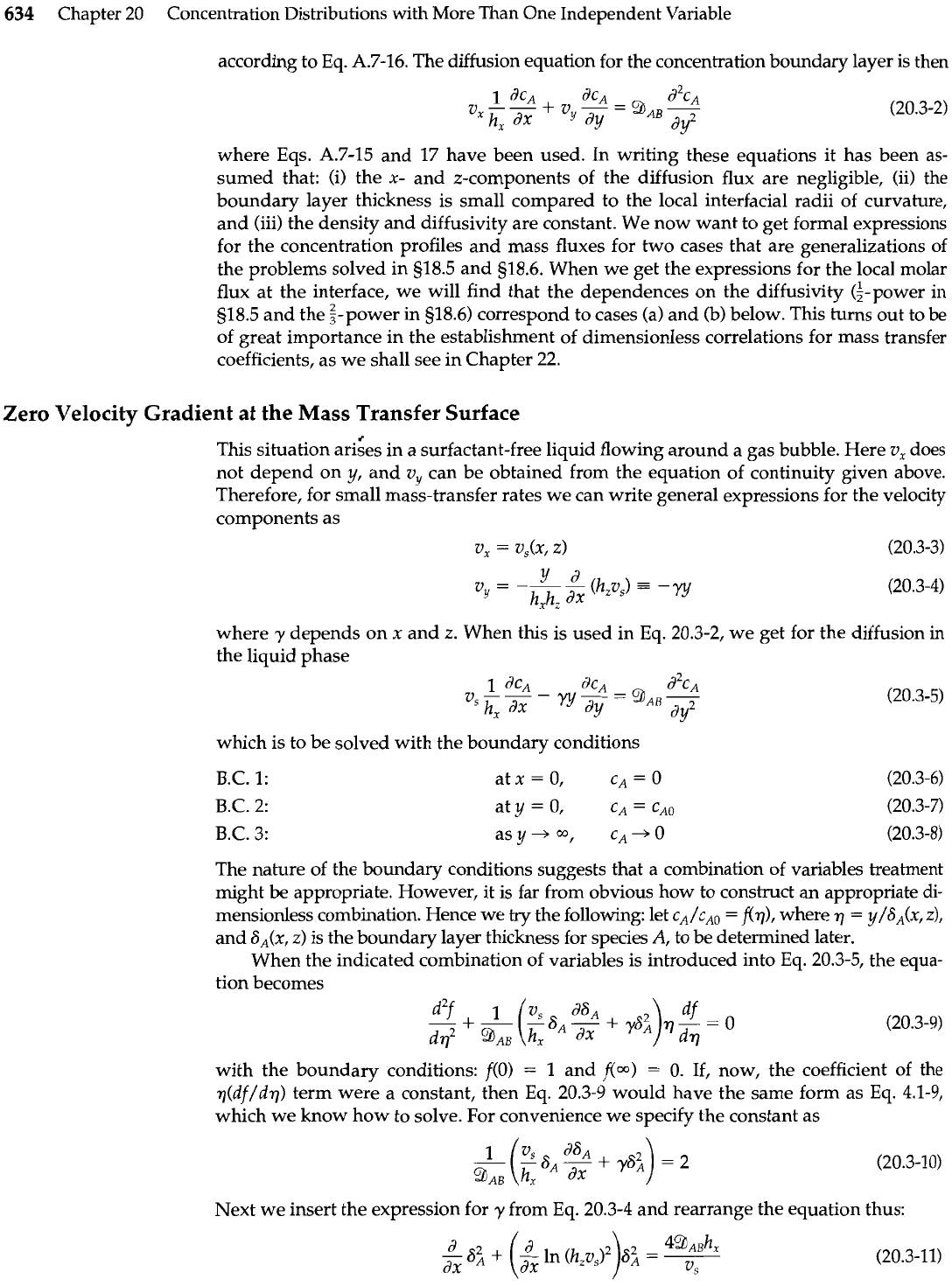
634
Chapter 20
Concentration Distributions with More Than One Independent Variable
according to Eq. A.7-16. The diffusion equation for the concentration boundary layer is then
where Eqs. A.7-15 and 17 have been used. In writing these equations it has been as-
sumed that: (i) the x- and z-components of the diffusion flux are negligible, (ii) the
boundary layer thickness is small compared to the local interfacial radii of curvature,
and (iii) the density and diffusivity are constant. We now want to get formal expressions
for the concentration profiles and mass fluxes for two cases that are generalizations of
the problems solved in 518.5 and 518.6. When we get the expressions for the local molar
flux at the interface, we will find that the dependences on the diffusivity ($power in
518.5 and the $-power in 918.6) correspond to cases (a) and
(b)
below. This turns out to be
of great importance in the establishment of dimensionless correlations for mass transfer
coefficients, as we shall see in Chapter 22.
Zero Velocity Gradient at the Mass Transfer Surface
This situation ariges in a surfactant-free liquid flowing around a gas bubble. Here
vx
does
not depend on y, and
v,
can be obtained from the equation of continuity given above.
Therefore, for small mass-transfer rates we can write general expressions for the velocity
components as
V,
=
v,(x,
Z)
(20.3-3)
where
y
depends on
x
and z. When this is used in Eq. 20.3-2, we get for the diffusion
in
the liquid phase
which is to be solved with the boundary conditions
B.C. 1:
B.C. 2:
B.C. 3:
The nature of the boundary conditions suggests that a combination of variables treatment
might
be
appropriate. However, it is far from obvious how to construct an appropriate
di-
mensionless combination. Hence we
try
the following: let cA/cA0
=
fir)),
where
77
=
y/6,(x, z),
and 6,(x,
z)
is the boundary layer thickness for species
A,
to be determined later.
When the indicated combination of variables is introduced into Eq. 20.3-5, the equa-
tion becomes
with the boundary conditions: f(0)
=
1 and f(w)
=
0. If, now, the coefficient of the
r)(df/dr)) term were a constant, then Eq. 20.3-9 would have the same form as Eq. 4.1-9,
which we know how to solve. For convenience we specify the constant as
Next we insert the expression for
y
from Eq. 20.3-4 and rearrange the equation thus:
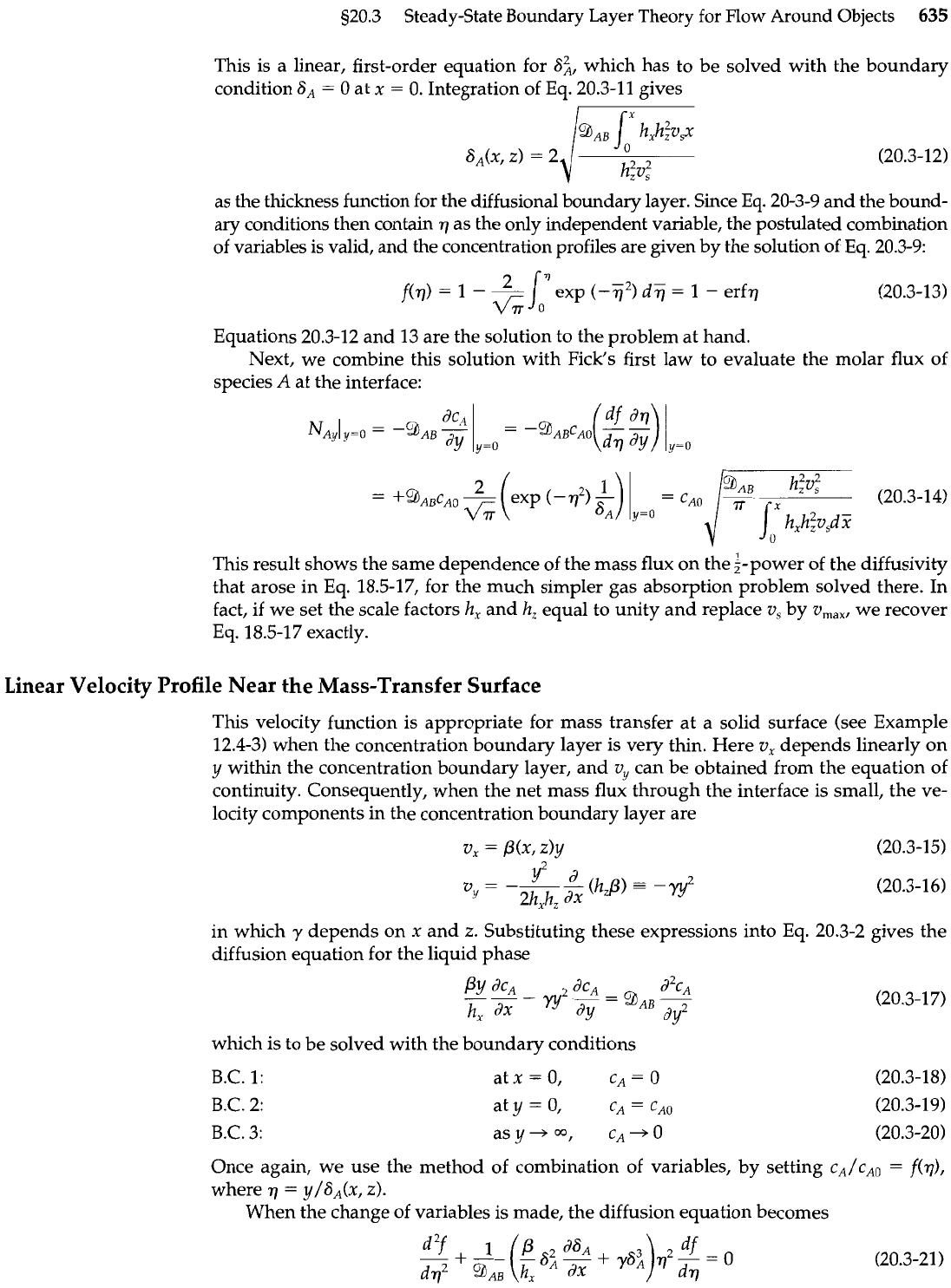
920.3 Steady-State Boundary Layer Theory for Flow Around Objects
635
Linear Velocity Profi
This is a linear, first-order equation for 6:, which has to be solved with the boundary
condition 6,
=
0 at x
=
0. Integration of Eq. 20.3-11 gives
as the thickness function for the diffusional boundary layer. Since Eq. 20-3-9 and the bound-
ary conditions then contain
7
as the only independent variable, the postulated combination
of variables is valid, and the concentration profiles are given by the solution of Eq. 20.3-9:
2T
f(7)
=
1
-
--
exp
(-7')
dTj
=
1
-
erfq
*
0
Equations 20.3-12 and 13 are the solution to the problem at hand.
Next, we combine this solution with Fick's first law to evaluate the molar flux of
species
A
at the interface:
This result shows the same dependence of the mass flux on the .$power of the diffusivity
that arose in Eq. 18.5-17, for the much simpler gas absorption problem solved there. In
fact, if we set the scale factors
h,
and
h,
equal to unity and replace v, by v,,,, we recover
Eq. 18.5-17 exactly.
.le Near
the
Mass-Transfer Surface
This velocity function is appropriate for mass transfer at a solid surface (see Example
12.4-3) when the concentration boundary layer is very thin. Here v, depends linearly on
y
within the concentration boundary layer, and vy can be obtained from the equation of
continuity. Consequently, when the net mass flux through the interface is small, the ve-
locity components in the concentration boundary layer are
in which
y
depends on
x
and z. Substituting these expressions into Eq. 20.3-2 gives the
diffusion equation for the liquid phase
which is to be solved with the boundary conditions
B.C. 1:
B.C. 2:
B.C. 3:
atx
=
0,
CA
=
0
aty
=
0,
C~
=
C~o
asy+m, cA+O
Once again, we use the method of combination of variables, by setting cA/cA0
=
f(q),
where
7
=
y/SA(x, z).
When the change of variables is made, the diffusion equation becomes
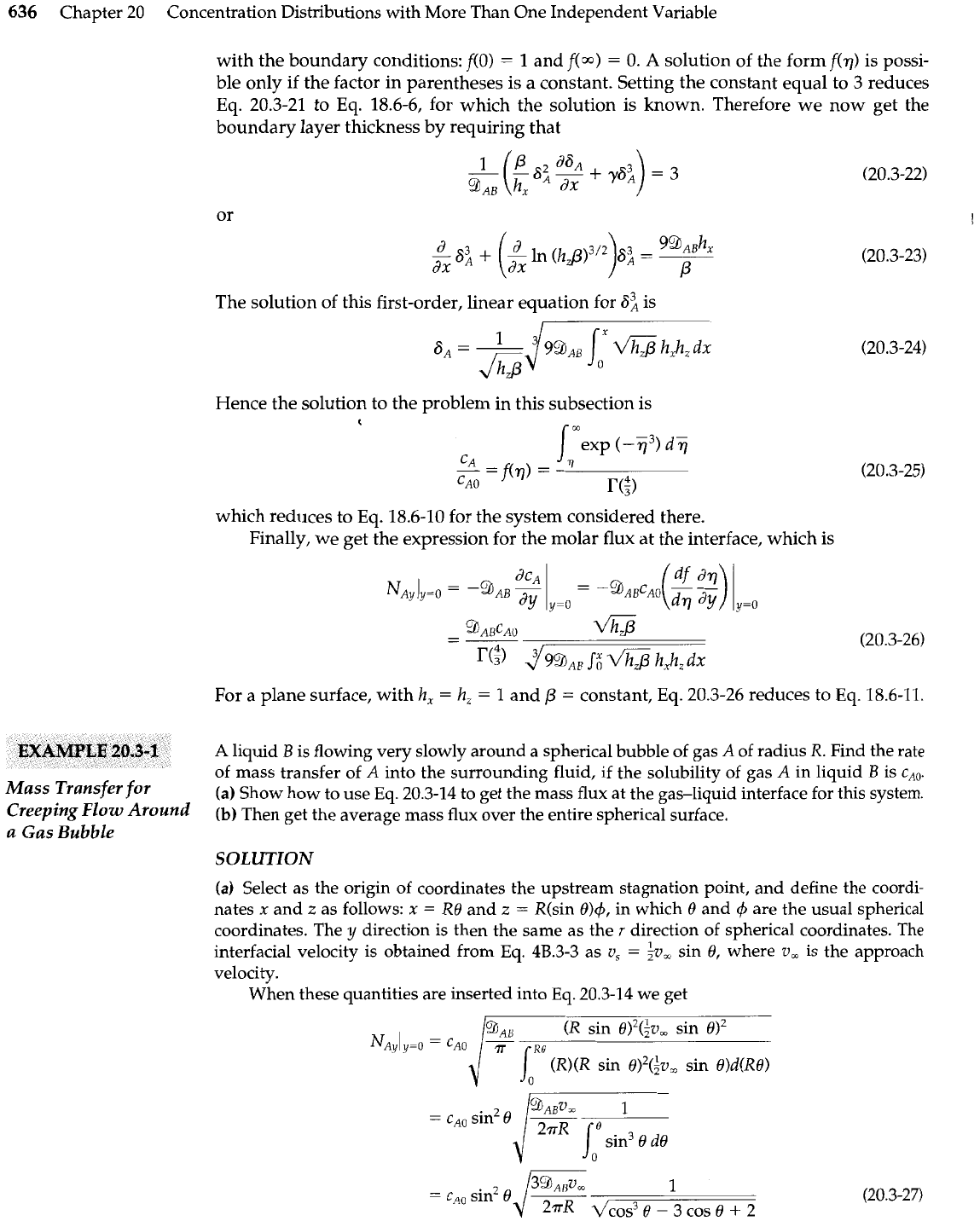
636
Chapter 20 Concentration Distributions with More Than One Independent Variable
EXAMPLE
20.3-1
Mass Transfer for
Creeping Flow Around
a
Gas Bubble
with the boundary conditions: f(0)
=
1
and f(m)
=
0.
A
solution of the form f(q) is possi-
ble only if the factor in parentheses is
a
constant. Setting the constant equal to
3
reduces
Eq. 20.3-21 to Eq. 18.6-6, for which the solution is known. Therefore we now get the
boundary layer thickness by requiring that
The solution of this first-order, linear equation for
61
is
Hence the solution to the problem in this subsection is
<
/vmexp (-ij3) dij
c
A
-
=
f(q)
=
C~~
r
(3
which reduces to Eq. 18.6-10 for the system considered there.
Finally, we get the expression for the molar flux at the interface, which is
For a plane surface, with
h,
=
h,
=
1
and
P
=
constant, Eq. 20.3-26 reduces to
Eq.
18.6-11.
A
liquid
B
is flowing very slowly around a spherical bubble of gas
A
of radius R. Find the rate
of mass transfer of
A
into the surrounding fluid, if the solubility of gas
A
in liquid
B
is
c~,.
(a)
Show how to use Eq. 20.3-14
to
get the mass flux at the gas-liquid interface for this system.
(b)
Then get the average mass flux over the entire spherical surface.
SOLUTION
(a)
Select as the origin of coordinates the upstream stagnation point, and define the coordi-
nates
x
and
z
as follows:
x
=
RO and
z
=
R(sin 8)4, in which
6
and
4
are the usual spherical
coordinates. The
y
direction is then the same as the
r
direction of spherical coordinates.
The
interfacial velocity is obtained from Eq. 4B.3-3 as
v,
=
iv,
sin 8, where v, is the approach
velocity.
When these quantities are inserted into
Eq.
20.3-14
we get
(R sin 13)~(iv, sin 8)'
0
=
(R)(R sin 8)2(:v, sin 8)d(R8)
